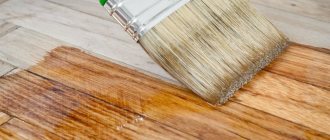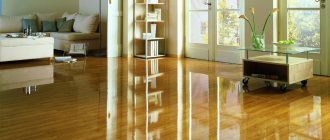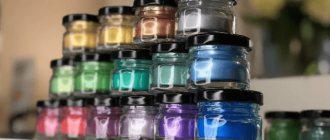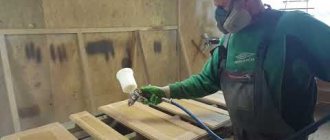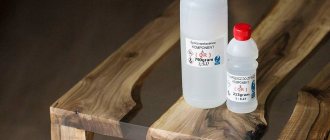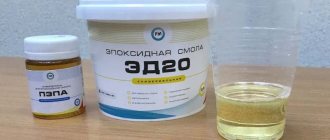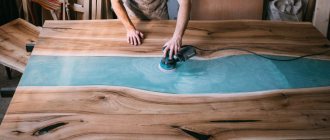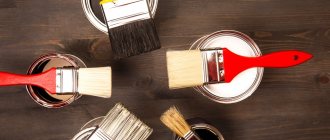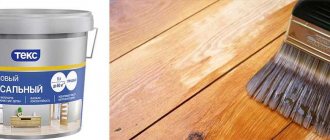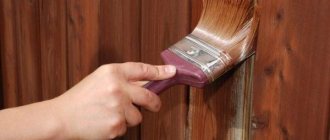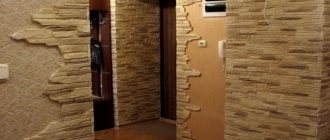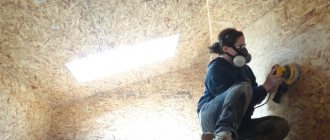How to cover a table made of epoxy resin and wood after sanding
If you are here, then most likely you do not yet know what is used to cover an epoxy resin and wood table after sanding. Furniture made by hand from natural solid wood, with an original shape and thoughtful design will always be an exquisite and unique decoration of any home interior. An interesting and unusual example of stylish indoor home decor would be a table made of wood and epoxy resin. The last, finishing touch when making the table will be the application of a protective, decorative layer.
Important! Modern tables filled with epoxy resin and wood are in incredibly high demand today because of their unusualness, originality and uniqueness. A little earlier, this material was used only in production and construction. Today, resin is one of the sought-after materials among many designers, since it can be used to make not only luxurious interior items, for example, tables, but also original jewelry. Epoxy tables are exclusive, and if you know the intricacies of working with this material, you can make such a table yourself, not only for yourself, but also for sale.
Can epoxy resin be coated with oil?
The surface of a sanded and polished slab of wood can be filled with epoxy resin, coated with teak or other varnish, or rubbed with a special oil and wax. ... You need to take a special varnish, the layer of which, after drying, will be absolutely transparent and indistinguishable from the main epoxy resin filling.
Interesting materials:
How to wear a jacket with jeans for a girl? How should you dress a newborn for a walk in winter? How should you eat right to be healthy? How to blow your nose correctly? How to close a loan correctly? How to protect yourself from power surges? How is mercury disinfected? How to combine two columns into one in Excel? How to combine into one object in AutoCAD? How to explain going to?
Preparing for work
The room must be well ventilated or have forced ventilation. The indoor air temperature should not be lower than 22 °C. High humidity and dust can ruin your work!!!
It is necessary to prepare materials for the manufacture of formwork. The formwork or form can be assembled from plywood, plexiglass (without scratches or chips) or polished aluminum sheets. You will also need release agents such as wax or semi-permanent release agents. For “home” use, wax is better. And if you are planning a series of countertops, then semi-permanent separators are better, they allow you to make more than 20 removals without rebuilding the separating layer.
Some home craftsmen use ordinary cosmetic Vaseline as a separator. It is easy to purchase, but it is difficult to perfectly align on the mold/formwork and it will cause clouding in places where it comes into contact with the resin. This layer will then need to be sanded.
Accordingly, you need to prepare tools for grinding, or at least a set of abrasive paper of different grain sizes for manual sanding.
Add a description
Don’t forget to prepare personal protective equipment for your loved one) These are gloves, a respirator, and safety glasses. A disposable painting overall and a cap will not be superfluous, because in its liquid state the resin seems to attract any speck of dust, lint, hair...)
Cover the floor and other horizontal surfaces in the area affected by the resin with polyethylene to keep them clean.
You will also need containers for measuring and mixing ingredients. Scales, accurate to 1 g. Or measuring cups, because Some resins are mixed by volume, and some are mixed only by weight, like EpoxyMaster.
Add a description
Polishing/sanding of the finished product
The product is considered finished after post-curing is completed; you can read more about this in the instructions for your resin. Post-curing allows your product to achieve its maximum properties. If post-curing is not possible or the instructions do not require it (not required), allow your product to gain strength. At a temperature of 22 -25°C this takes 5-7 days. Well, now you can start grinding and polishing work.
Attention! Wet the surface with water to avoid overheating your product, otherwise the resin will begin to melt and clog the abrasive paper. Well, or choose a speed mode that does not lead to overheating.
The final touch is to coat the product with UV-resistant polyurethane varnish in several layers, with intermediate sanding. This will save your masterpiece from yellowing due to exposure to sunlight and will give the piece a much brighter shine than polishing.
Design and construction features
Epoxy resin tables are characterized by a unique design and can fit into any interior. Most often they are used in kitchens and living rooms, and there are no strict requirements for the style solution. Epoxy is used not only to make new products, but also to restore old furniture. Many models are made by combining several materials.
The peculiarity of the resin is that it hardly shrinks after hardening, therefore it retains its original shape for a long time. In addition, it can be decorated in different ways. Resin tables come in several types of designs:
- Combined. In this case, synthetic material alternates with wood elements.
- With the presence of support. Only the top layer is filled with resin. Additionally, various decorative elements are used: leaves, coins, flowers.
- Without the presence of support. There is only epoxy here. Small coffee tables are made this way. They are not intended for significant mechanical loads.
The product can be transparent, single-color or combined. The most commonly used are light turquoise and blue shades. Often the design is equipped with additional lighting or fluorescent powder. Handmade tables have a high cost, but such furniture can be made independently. The advantage of the process is that the cost of the model is reduced. There are other advantages: the opportunity to show imagination, restoring old furniture in an original way.
Combined
With the presence of support
Without the presence of support
Difficulties
The theoretical description of any process always seems elementary, but when it comes to practice, certain difficulties arise. It’s good if the master knows about all the nuances in advance. After all, unexpected difficulties can slow down the process, and in some cases this will lead to damage to the material.
The first snag that awaits the novice master is the production of high-quality formwork. It is necessary to understand that a viscous resin still remains fluid. All cracks must be properly sealed. If the epoxy starts to flow out of the mold, then the process cannot be reversed, that is, there is only one chance to fill it. In this case, the sides of the formwork must be strictly horizontal.
When mixing the main component with the hardener, it is important to obtain a uniform mixture. Otherwise, zones with different densities are formed
Uneven curing or areas of liquid resin will negatively impact both the appearance and durability of the countertop.
Some sources contain recommendations for pouring, which indicate that in order to obtain a slab of the correct geometric shape, you need to pour resin over the entire area, and if necessary, push the elevations into the corners with a spatula. In fact, the filling technology is fundamentally different from the recommended one. First, you should moisten the corners with resin so that no air cavities form in them when pouring. Resin is poured into one point. It is useful to use a stick; one end of it is placed in the mold, and the composition is poured over the stick.
The real problem is the appearance of air bubbles. You won’t be able to avoid this, but you can reduce their number and effectively deal with the remainder. An area of resin is heated with a hairdryer and bubbles come to the surface.
The entire procedure should be carried out with extreme caution so as not to provoke even more bubbles.
Types of varnishes
Acrylic varnishes (glossy and matte)
Acrylic varnish is the most popular and sought after type of coating among needlewomen. Most often you can find water-based acrylic varnishes on sale, but turpentine-based varnish can be used for oil painting.
The composition is based on colorless, unpainted acrylic resin with the addition of various stabilizers and thickeners.
Acrylic varnish has many advantages. This type of varnish can be considered universal in many respects. First of all, it can be used to cover surfaces made of various materials: wood, plaster, stone, glass, ceramics, cardboard, etc. It is also used not only as a finishing coating, but also mixes well with water-based paints (gouache, tempera, acrylic), giving them greater color saturation. When added to gouache paints, it additionally gives it abrasion resistance.
After drying, the varnish becomes water-insoluble, which allows the surface of the product to be cleaned using aqueous solutions. Acrylic varnish can be applied as a primer on a wide variety of substrate materials. The gypsum surface, after applying primer in the form of acrylic varnish, crumbles significantly less, and it imparts additional rigidity to the textile substrate.
It is common to use acrylic varnish as a binder for making paints yourself; it gives them depth of color and a silky gloss.
Acrylic varnish is indispensable in decoupage. It is actively used as a finishing coating for various decorative products: boxes, watches, panels, mirrors, figurines and photo frames. Acrylic varnish is excellent for revarnishing colored coatings, and also allows you to soften the boundaries of transitions and protect the intermediate layers of the product.
The varnish is already ready for use; there is no need to further dilute it. However, if the varnish has thickened, it can be “revitalized” simply by adding a little water. Also, experienced craftswomen advise that when applying the first layer of varnish, make it as liquid as possible, and subsequent layers are thicker.
The main disadvantage of this type of varnish is that for its normal crystallization, it is necessary to maintain air humidity of at least 50% during the entire drying period, which is very difficult to achieve in winter.
To summarize, acrylic varnish is water-soluble, practically odorless, does not burn, becomes completely transparent after drying, does not turn yellow over time, and can be used on almost all materials. Environmentally friendly material. There are three types - glossy, matte and semi-matte (satin). For application use synthetic brushes or rollers. Manufacturers also offer varnish in the form of an aerosol, the use of which allows you to achieve a more uniform coating, without brush marks.
Choose acrylic varnish
Alkyd varnish
Alkyd varnish is based on a mixture of alkyd resins with an organic solvent. This type of coating is characterized by high moisture resistance, tolerates sudden temperature changes, and has high decorative qualities. It has no equal in creating a protective layer that prevents mechanical stress. Alkyd varnish, penetrating into the deep layers of wood, emphasizes the natural beauty of the material.
Alkyd varnish is used to cover products that will be used intensively. When applied to wood, it becomes not susceptible to rotting and fungus, and alkyd varnish protects metal products from corrosion. Products coated with alkyd varnish are fire-resistant.
The consumption of alkyd varnish is significantly less when compared with acrylic varnish.
The main disadvantages are that it is toxic, has a fairly long drying period, and also has a pronounced unpleasant odor. It is necessary to work with such varnish in a well-ventilated area, taking all necessary precautions to avoid intoxication.
For application, brushes or special rollers with a porous base are used.
Nitrolac
Nitrovarnish is a synthetic varnish that has a similar composition to alkyd, but dries much faster. The scope of application of nitro varnish is the creation of a protective and decorative coating for wood products. After varnishing, the product can be polished.
The varnish is ready for use and does not require preliminary priming of the surface, as it has high adhesion. Apply by brush, roller or spray gun.
Yacht varnish
Yacht varnish belongs to the construction varieties. As a coating for creative works, yacht varnish has proven itself to be an excellent topcoat for products that are used in harsh weather conditions: weather vanes, feeders, door signs, outdoor decorative elements. Such products are often made using the decoupage technique.
Tsapon
It is a mixture of artificial resins and nitrocellulose. Organic dyes can be added to the varnish.
A distinctive feature of Tsapon varnish is heat resistance. The coating is applied in two layers over acrylic varnish. Used for decorating thermal mugs, hot pads, tabletops, trays.
The varnish has an unpleasant odor because it is diluted with acetone.
Polyurethane varnish
Polyurethane varnishes, unlike alkyd varnishes, are water-based, so they are practically odorless, non-toxic, and dry quickly. There are oil-based options that are more moisture resistant.
Polyurethane varnish is ideal for decoupaging cutting boards, but only the side that is not being used for cutting should be varnished. We recommend soaking the other side with linseed oil, which will protect the wood and be completely safe for health.
Also, polyurethane varnish is well suited for decoupage of products that are used in the bathroom, bathhouse or sauna: shelves, hangers, various decorative elements.
Polyurethane varnish without a latex component is used to coat polymer clay products.
This coating is safe for health, non-toxic, significantly increases the service life of products, and effectively protects against moisture and mechanical stress.
Glue varnish for decoupage
As the name suggests, adhesive varnish performs two functions at once: it holds the layers together and protects the product from external factors. It is produced on a water basis; the addition of acrylic helps protect the surface from mechanical damage.
Unlike ordinary PVA glue, the specialized composition does not turn yellow, and the texture ensures uniform application. However, to provide greater strength, it is recommended to additionally use a finishing compound.
Select adhesive varnish
Shellac
Shellac is considered the first varnish that craftsmen began to use to decorate their works. It is based on a natural resin secreted by a certain type of insect.
Shellac can be used as a topcoat on any type of paint, but it looks best on metallics.
Shellac is one of the few types of varnish that can be used to decorate gold leaf. An interesting effect is obtained when decorating plaster with shellac, since shellac can be not only transparent, but also colored. If you impregnate gypsum with shellac and rosin, the appearance of the gypsum tiles will look like marble.
Craquelure varnish
Craquelure varnish is used by artists for the process of the same name - craquelure, or, simply put, aging a painting. Craquelure varnish is used in decoupage in a similar way.
There are two types of craquelure varnish - one-step and two-step. In the first option, the varnish is applied between two contrasting layers of paint. The second option involves applying a layer of shellac.
To work with craquelure varnish, only a synthetic brush is used, and there should be no dust in the room itself.
At the end of the work, the product is coated with a protective acrylic (or other suitable) varnish, since the coating serves a purely decorative function.
Choose craquelure varnish
Retouch varnish
Used as an intermediate layer in oil painting. Improves the adhesion of paint layers and maintains their brightness. The varnish film has a reversible effect - it dissolves easily in special liquids. In this regard, this varnish cannot be used as a topcoat - it has the opposite effect. For application use a swab or brush.
Dammar varnish
Used as an additive to paints or as a topcoat, it has a thick consistency. The main advantage is the ability to protect the canvas from exposure to ultraviolet radiation. Dammar varnish improves the optical properties of paints. However, over time, this varnish turns yellow, so it is not recommended to use it for paintings painted in cool colors.
The disadvantage of dammar varnish is its hygroscopicity, that is, it is permeable to moisture. In conditions of high humidity it becomes cloudy and does not provide the painting with the required level of protection.
Vitreous varnish
It has high plastic properties and wear resistance. It is advisable to use glassy varnish as a finishing coating for leather products made using the decoupage technique (wallets, book spines, document covers, business card holders, leather shoes). It forms an elastic, abrasion-resistant film.
Bitumen varnish
Ideally fits on any surface, after drying it forms a transparent dark film with a pleasant brown tint. Used for artificial aging of products. Performs a purely decorative function. How “old” the top layer of the product will look depends on the degree of rubbing of the bitumen varnish. Ideal for paints that imitate the color of metal, giving them an additional metallic shine.
On top of the bitumen varnish, to protect the craft, it is necessary to apply several layers of a finishing coating selected in accordance with the material of the product. Bitumen varnish is applied with a brush, and the resulting excess is removed with a cotton swab or natural cloth.
Faceted varnish
Refers to varnishes for decoration. Its properties are similar to craquelure varnish, but it has the consistency of a thick paste. When dry, it gives very impressive cracks. Mainly used for decorating glass products using decoupage technique. For the finishing coat use glossy acrylic varnish. The combination of patina on beveled varnish is very impressive. The varnish looks beautiful on plates, stained glass windows, and Christmas tree decorations.
A special feature of the application is the use of a palette knife.
Main advantages
Products coated with epoxy resin have excellent technical characteristics and performance characteristics. In addition to the fact that this material has an affordable price, it also has the following advantages:
- high resistance to moisture and water;
- excellent strength and resistance to mechanical stress;
- attractive shine;
- harmless to human health;
- resistance to chemicals;
- abrasion resistance;
- can be used for parquet, concrete, wood, furniture, ceramics.
Payment rules
When paying for an order with a bank card, payment processing (including entering the card number) takes place on a secure page of the processing system, which has passed international certification. This means that your confidential data (card details, registration data, etc.) are not sent to the online store, their processing is completely protected and no one, including our online store, can obtain the client’s personal and banking data.
In case of a refund, the funds are returned to the same card from which the payment was made.
Attention! Dear customers, we inform you that when requesting a refund upon cancellation of a purchase, the refund is made exclusively to the same bank card from which the payment was made!
Available means
Gel food colors
You can use some available materials as paints for epoxy resin:
- gel dyes for baking;
- ink from gel and ballpoint pens;
- watercolor paints with minimal dilution with water;
- soap dyes;
- eye shadow and nail powder;
- dry food coloring;
- printing inks;
- automotive enamels;
- alcohol solution of brilliant green;
- potassium permanganate crystals;
- crushed crayons and pencil leads.
The use of improvised materials as dyes does not always give a predictable result. Only professional colors give the desired effect - bright, beautiful and exactly matching the declared shade.
Popular modifications
Making a table from epoxy resin is a task for a craftsman with good imagination. In addition to standard pieces of wood, luminescent paints or powders, buttons, wine corks, moss, plant leaves, sea stones, and cobblestones can be used for decoration.
River
A special feature of the river table design with epoxy resin is that it is based on the same placement of elements: an insert made of the specified material is localized between two pieces of wood. It can be straight or follow the curves of the tree, wide or narrow, with decorative fragments, islands, and stones.
The shapes of the tabletops here are different: round, oval, rectangular. Interesting options are in which wood plays the role of a river bank, and resin plays the role of water. These products can be installed in the living room and kitchen. The model looks great in the office. With a river you can make a coffee table in Provence or country style. As for material consumption, about 13-14 kg of substance is needed for a river measuring 210 x 15 x 5 cm.
Solid surface
To create a solid table made of liquid glass, you need to use a mold of the required size. Most often, such structures are made without support and do not provide for intense loads. Tabletops of this type are used for the production of coffee tables or dressing tables. To make an epoxy resin tabletop, the dimensions of which are 100 x 60 x 5 cm, approximately 30 liters of resin are required.
From slab
Slabs are solid massive slabs of wood or stone. To make such a product at home, lighter material is taken. The tree usually represents a longitudinal cut of the trunk with remaining knots and uneven edges. This will allow you to create a unique model.
Often a slab table is made of oak. In this format you can make a kitchen surface, a structure for a living room, or an office. The thickness of the wood material ranges from 5 to 15 cm. It should not be glued or have other joints. To make a table from medium-sized epoxy resin slabs, you will need about 10 kg of the substance.
From cuts
Solid wood tables look very original and rich. Models of saw cuts of wood material coated with an epoxy solution look no less impressive. To fill such a countertop, a minimum of 7 kg of polyester substances is required. This model is perfect for kitchens, cottages in country style, eco-friendly. No matter what kind of hemp or solid trunk the cuts are made from, the design of each of them will be unique.
Tables of this type have different shapes: round, oval, rectangular and even square. The number of fragments used depends on its choice. The material must be of high quality and the required diameter. Cracked elements are not recommended to be used.
